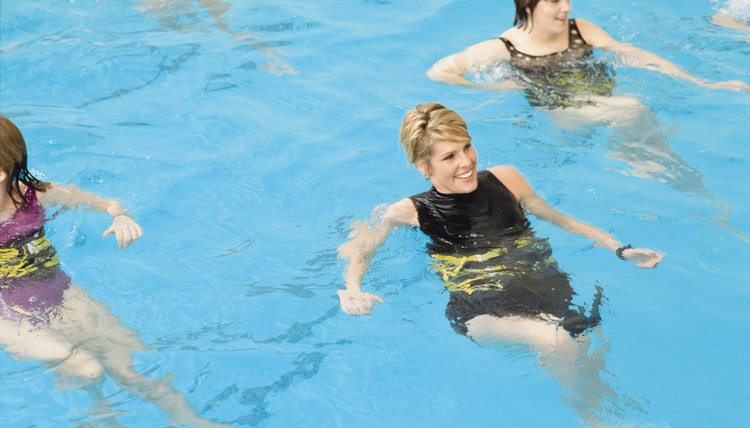Water Aerobics in Shallow vs. Deep Water

Water-based fitness appeals to many types of exercisers: seniors, people with joint problems, obese people and those who simply love moving in water. The aquatic environment provides both buoyancy and resistance. Aqua aerobics classes are typically taught at three depths: waist deep, a depth between chest and shoulder height and deep enough so you can’t touch the bottom. Stick to the shallower depths unless you’re an accomplished swimmer. Both shallow and deep-water exercise classes offer many of the same benefits as land-based exercise, including toning muscle, improving posture and balance, increasing flexibility and burning calories.
Depth
For shallow-water classes, the Aquatic Exercise Association (AEA) recommends pools that range in depth from 3 to 5 feet. These depths will accommodate a variety of student heights. Standing in water that’s between chest and shoulder deep will support 80 to 90 percent of your body weight and allow you to do some maneuvers with your feet off the bottom. Pools that gradually slope on the bottom are best and will cut down on musculoskeletal stress. A depth of at least 6.5 feet works best for deep-water classes, so your body can be suspended vertically with no impact or weight bearing. Deep-water participants often use flotation devices to help them stay vertical.
Intensity
Exercise scientists know that your heart rate is slower in water than on land. But they still haven’t calculated just how much slower. Leading theories now suggest this varies greatly from heart to heart and that previous calculations were grossly inaccurate. Some of the reasons for this lowered heart rate include gravity, water temperature, partial pressure and reduced body mass, combined with each student’s age and fitness level. This difference is especially pronounced in deeper water. So if you’re doing deep-water aerobics, you might be working harder than your heart rate suggests. Therefore, use the Borg scale of perceived exertion, rating your work level at 6 to 20, or the easier-to-use modified scale of 1 to 10, instead of relying on heart rate.
Cadence
The Aquatic Exercise Association recommends that instructors choose music with different tempos depending on whether they’re teaching shallow or deep-water aerobics. For shallow-water classes, the AEA suggests 125 to 150 beats per minute, and for deep-water classes, the AEA suggests 100 to 125 beats per minute. However, keep in mind that participants move at half tempo due to the slower reaction time when they're submerged.
Equipment
For deep-water classes, the AEA recommends attaching a flotation vest or belt to your torso. More advanced deep-water exercisers can use ankle cuffs. You should attach your flotation device to your body -- rather than just holding onto a kickboard or foam noodle -- because then you can’t accidentally let go if you panic. You might use additional hand-held buoyancy equipment in both deep and shallow-water classes to provide resistance for upper-body exercises. The AEA recommends aquatic shoes for shallow-water classes, especially if you’re diabetic, pregnant, obese or have musculoskeletal disorders. You might also need goggles if the class involves submerging your head.
References
Resources
Writer Bio
Teresa Bergen writes about fitness, health, yoga, travel and the arts. She is the author of "Vegetarian Asia Travel Guide" and has written hundreds of articles for publications online and off. Bergen also teaches yoga, spinning and group fitness classes, and is an ACE-certified personal trainer.
